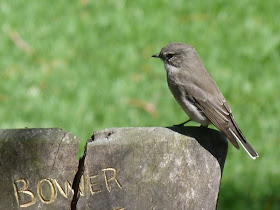I suspect that the majority of Canberrans make the 150km journey across the edge of the Monaro Plains, through historic Braidwood and down the steep curves of forested Clyde Mountain to Batemans Bay at least once a year. Many own or have access to holiday homes of varying grandeur or simplicity up and down the coast; we don't, though we do spend three or four weekends a year there in general. 'The Bay' is a sprawling conurbation now, but there are still quiet little off-road settlements nearby. We have a flexible set of rituals while we're there, but one unbreakable rule is a visit to the delightful Eurobodalla Regional Botanic Gardens, 42 tranquil hectares of forest and open space dedicated to local native plants.
As you will have by now divined, this is to be another in my occasional series on favourite botanic gardens, the most recent of which you can find here.
The story of the ERBG (if I may be so familiar) is above all one of community spirit and an unusually successful co-operative venture between community, local government and a state government department. In 1986, in a reversal of the usual way of doing things, a Friends group was formed to press for a local native botanic gardens. In 1988 the Eurobodalla Shire came on board, and NSW State Forests was convinced to lease the selected area - which had not been logged for 100 years - to the shire for use as a botanic gardens. A management committee was established to oversee the development. Most of the financial support comes from the shire, with the help of government grants and vigorous fund-raising by the Friends.
 |
| As a result of being unlogged since the early 20th century, there are some big original eucalypts in the forests of the Gardens. |
The path has not been easy. A massive bushfire in January 1994 set development back a long way. In September 2010 a destructive storm brought down numerous trees, one of which crushed the new orchid house just prior to its scheduled opening. Some of the 7km of walking tracks are still closed following that event, awaiting the funds to clear them.
Nonetheless they are now a delight to visit. The first thing a visitor encounters is the cafe and visitors' centre, which come into view as we cross a little bridge over Pat's Creek, usually busy with birds.
 |
| The Chef's Cap Cafe is on the left, with the Wallace Herbarium on the right. The tower provides cooling in summer by drawing up hot air from the buildings. |
 |
| We always indulge in at least a coffee, if not lunch, at the cafe, attended invariably by busily speculative Superb Fairy-wrens. |
 |
| Superb Fairy-wren Malurus cyaneus male, moulting into his plain winter garb, sharing a table at the Chef's Cap Cafe. |
The garden beds emphasise plants suitable for home cultivation, as well as special theme plantings including dryland, wetland and sensory gardens. Plants propagated by the horticultural team but surplus to Gardens requirements are available for sale; some unusual species can be found on occasions. This Easter there's a big sale of these plants on - see here for more details.
 |
| Looking south from the Visitors' Centre. |
 |
| Chef's Cap Correa Correa baeuerlenii, from which the cafe takes its name. It is limited to about 150km of forests south from here. |
Three quarters of the area is retained as original forest, with walking tracks winding through.
 |
| Wet sclerophyll forest along the gully of Deep Creek. |
The tracks feature information signs, including on indigenous usage of local plants.
 |
| Discussion of indigenous use of Burrawang, the cycad Macrozamia communis, alongside the plant. |
The ten hectares of cleared land were already cleared when the site was chosen; they are designed to encourage use, for picnics and family gatherings. Children are well-catered for.
 |
| Excellent playground, including large robust musical instruments, such as the 'harp' below, played by hitting with the metal pipes supplied and tied on! |
 |
| All-weather picnic shelter. |
 |
| Covered stage at amphitheatre, used for concerts. |
 |
| Orchid house, built to replace the one destroyed in the 2010 storm. |
Water features strongly throughout the gardens; water for the ponds is mostly drawn from Deep Creek.
 |
| Two of the rich, near natural-seeming artificial ponds. |
 |
| From the bird hide looking out over extensive wetland at the north-western end of the Gardens. |
And speaking of birds, they are of course another feature; here are just a couple that I've photographed here at different times.
 |
| Jacky Winter Microeca fascinans, an Australian robin, which hunts insects by 'perching and pouncing'. |
 |
| Eastern Whipbirds Psophodes olivaceus are generally cryptic, but sometimes come out to feed on the lawns here. |
 |
| Australian Wood Ducks Chenonetta jubata, appreciate both the ponds and the lawns where they graze. |
 |
| Fan-tailed Cuckoos Cacomantis flabelliformis are spring and summer visitors, when their perpetual downward trills compete with the cicada chorus. |
The gardens are well-marked on the left about five kilometres south of Batemans Bay on the Princes Highway. Bearing in mind that they're closed on Monday and Tuesday, make sure you put some time aside to visit next time you're down that way. Have a look here for some more information. Beware before you visit though - you'll be hooked too.
BACK MONDAY



Sounds a great place. I'll have to try and visit it next time we are over.
ReplyDeleteYes, put it on your to-do list! You'll love it and they deserve your support.
ReplyDelete